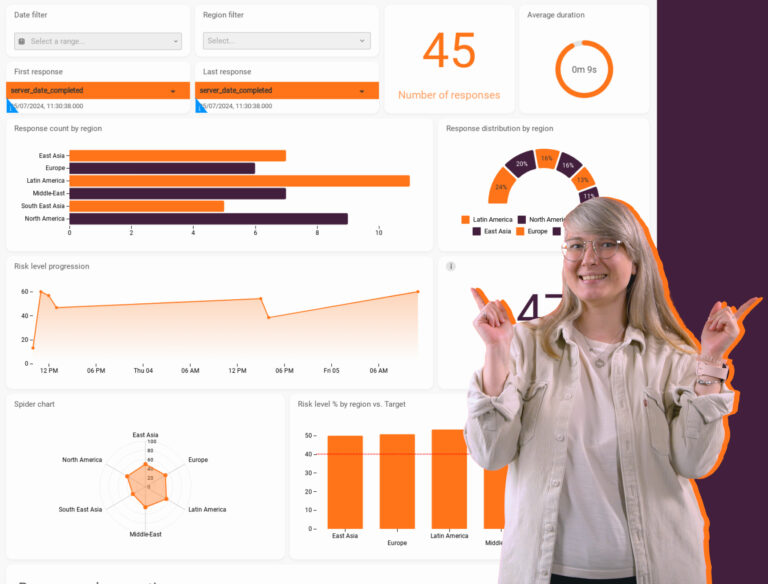The fact that communities benefit from diversity should not be news to anybody. One type of diversity you may not have heard of as much is neurodiversity. Nonetheless, insightful awareness of it is essential for individuals to thrive, along with their communities and the organizations they work for. In this article, you’ll learn more about it, and the helpful role of online assessments and digitalization in general.
Together with Pointerpro Marketing Director Ine Wouters, I had the pleasure of interviewing the CEO, the Operations Director, and the Learning Technologist at Connections In Mind, a UK Community Interest Company that’s democratizing the important professional expertise around “executive functions”: The cognitive processes that are crucial for managing behaviors and tasks. Their efforts are therefore especially essential for supporting people with autism, ADHD and dyslexia.
In this article:
- A professional approach to the community interest: How Connections In Mind supports executive function challenges
- How the digitalization of services contributes to Connections In Mind’s success
- The pivotal role of a longitudinal online assessment for neurodivergent people’s journey with Connections In Mind
- Productizing and monetizing automated assessments in the future
- The overall satisfaction with Pointerpro
A professional approach to the community interest: How Connections In Mind supports executive function challenges
Victoria: Connections In Mind has grown incredibly over the last few years. We started out in 2015. But really since covid, people have become much more aware of their mental health. In the UK there has been a massive rise of people being diagnosed with neurodivergent conditions. And since we were already established, we’ve been able to contribute a lot. Of course, there have always been neurodivergent people – people just tended to attribute negative connotations to people who struggle. Now, the world has just become more understanding of it. And we’re happy to be pioneering, working with schools and individuals.
So can you briefly explain a bit more what executive functions are? What should people who are unfamiliar with it know about it?
Victoria: Okay, so our executive functions are our brain processes that help us to get things done. They’re found in the prefrontal cortex of our brains. They work optimally when we’re feeling satisfied: When we’re well rested, when we have connected with people we love, when we aren’t stressed, etc.
What we know from the research is that every single person on this planet will struggle with their executive functions to some degree every day, but some more than others. In the past we thought of executive function differences as character flaws. But now we know it’s just a matter of people’s brain functioning differently. People that are often very creative and can add a lot of value to society.
Learning about executive functions, implies learning about how our brains work. And it’s that educational piece we try to achieve with Connections In Mind. We believe that if you can understand how your brain works, you can be kinder and less judgmental to yourself and others. This is what leads to a more supportive and compassionate society.
Speaking of Connections In Mind as an organization: You’re a Community Interest Company. What does that entail?
Victoria: Yes, so we are a community interest company now, but we weren’t always a community interest company – or at least, not classified that way under the UK law. We were a standard limited company for a while but always with the same mission.
We found that the for-profit-nature of our business was off-putting for some people, even though we weren’t making huge profits.
We were also confronted with the fact that we weren’t getting certain grants for which we applied in order to do our work. So we’re happy to have moved into the Community Interest Company space – not to change anything about what we’re doing, but really to be recognized as such. It’s a little more complicated to administer, but not too much. The bottom line is: We want to serve the community of neurodivergent people, who we believe have unwittingly been discriminated against for many years. We want to help these people.
How the digitalization of services contributes to Connections In Mind’s success

“It’s because we’re digital that we’re able to have that global reach” - Victoria Bagnall (CEO & Co-founder)
Let’s dive into some more detail: How do you help the community of neurodivergent people?
Victoria: We support them in myriad ways. We have our Connected Club, which is essentially free at the point of use. Although we do have a subscription fee, but most of our members access it for free. We have 1-on-1 coaching – and actually a lot of it is government funded coaching both for adults and children.
And we train executive function coaches to do their work. For instance, we’re doing a big piece of work with Ernst and Young in the USA, and with Berkeley University. There seem to be amore and more stateside companies and organizations that are interested in this.
It’s because we’re digital that we’re able to have that global reach. We do a lot of training of managers and lecturers. We also work with schools globally, very regularly. I’m doing a training at the end of next week, which will be online for a school in Switzerland. I’ve done several ones for schools in South Korea, Japan and so on and so forth.
So on one hand the goal is to help people be kind to themselves about the challenges that they have and work on their goals so that they can feel success and contribute to society. But also it’s about educating the people around those people so that they can get rid of their unconscious bias against these challenges.
Very interesting. You mentioned the Connected Club, your online community. I was impressed with all the content there. Can you tell us more about it?
Victoria: Absolutely. So the Connected Club is something that we offer for anyone who’s neurodivergent: whether they self-identify or whether they’ve got a diagnosis. Everyone’s able to join. Very often, people who have filled out the questionnaire come and join us. So they’ve filled it out. They realize they have certain challenges, and then they join us.
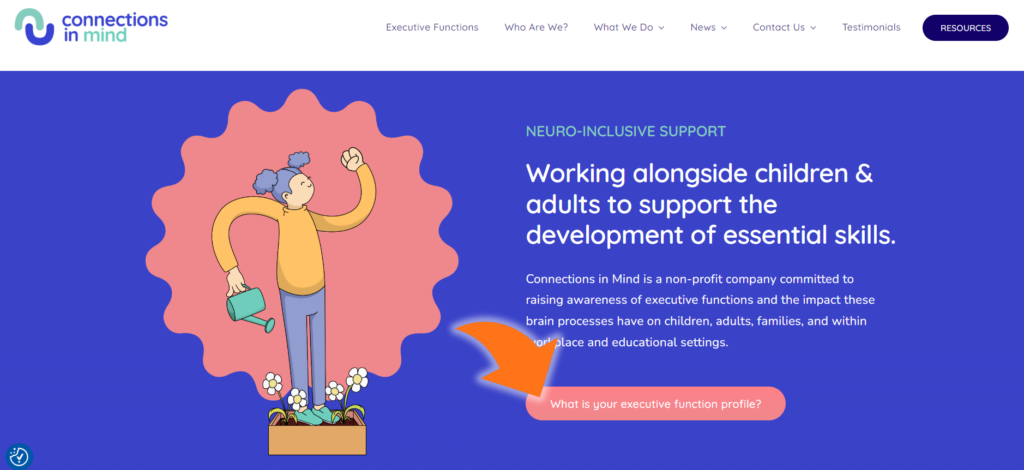
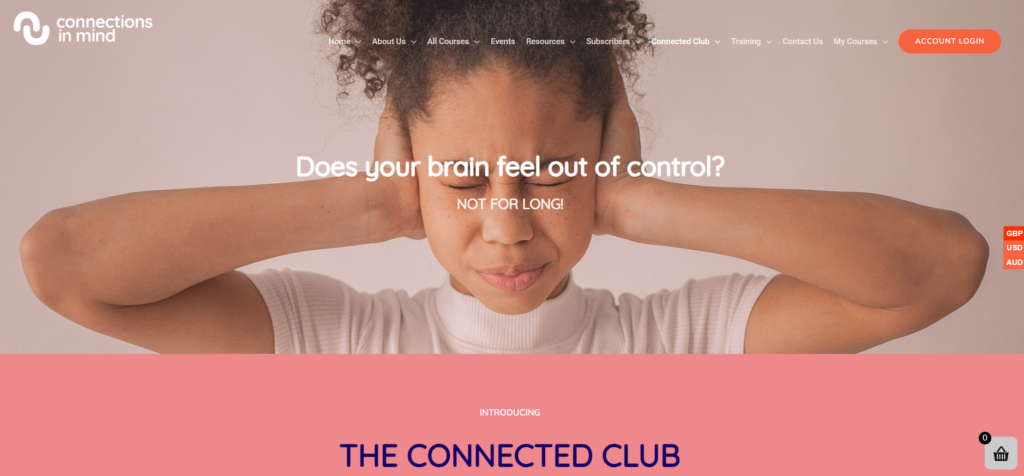
And the most popular element of it is that it’s an online community of people who get together for a drop-in session. Meaning: We don’t ask people to sign up. They can just drop in.
So we never quite know how many people we’re going to get. But that’s all part of the fun. And so that happens on every Thursday evening with a very highly qualified neuropsychologist who facilitates the group. And on top of that we’re training some of our members to be able to co-facilitate as well, so we can have breakout rooms of different people talking about different topics. It’s a really lovely community of people.
And so that takes place every week?
Victoria: Yes, and then on top, every other week, we have what we call “strategy sessions.” They take place with another one of our coaches who’s very experienced.
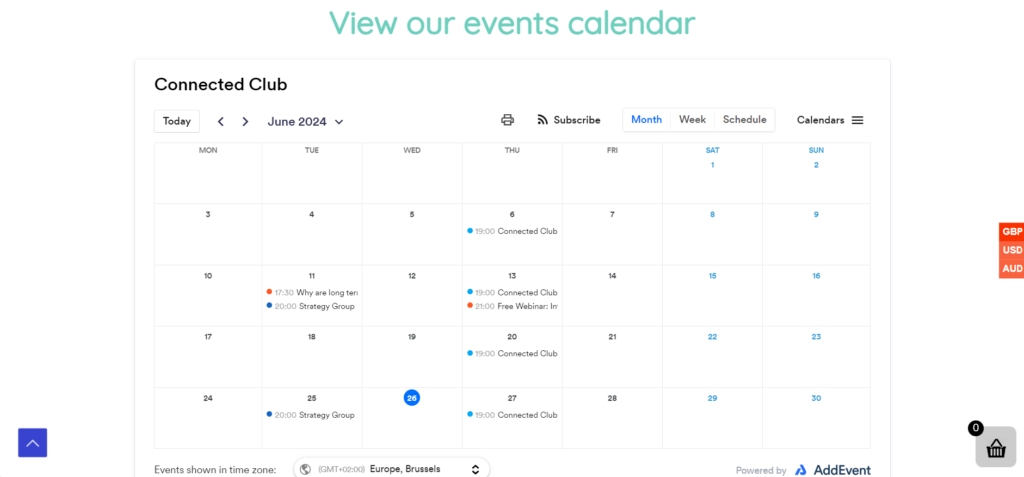
This is about helping people work out strategies that work for them personally to overcome some of the challenges that they face. So it can be something very specific such as making sure that you remember your shopping list. It sounds a bit ridiculous when you say it, but I’m for instance someone who’ll write my shopping list, have all the things that I need on it, and then leave it on the kitchen table, you know? So it can really be about very hands-on things like that.
Nice. And there are also other types of content that don’t require live attendance, I understand. What are some of the digital tools involved there?
Victoria: Yes. We have a variety of content on our LMS-system. We use LearnDash on WordPress. And so we have what we call “neuro-insight modules.” They are bite-size modules of less than 10 minutes long. We know from our research that with any video longer than that, people switch off and they don’t watch the end. So these are short 6 to 10 minute videos about how hormones affect the brain, how something that’s called BDNF – which is sort of a fertilizer – affects the brain, how alcohol affects the brain, and so on.
We also have some self-help modules. So, these are once again more around strategies to adopt, and things that we can do to help ourselves with our specific challenges. And then we have a whole host of printable resources that people can download and use: Weekly planners, meal planners, procrastination worksheets. We have all these amazing resources that people can access to provide them with great support.
And so what we’ve done, really, is pull together the digital and the in-person experience, but it’s all online. It’s something we’d really like to do more of. We’d like to create an end-to-end bespoke journey for our community members that would start with a Pointerpro-built questionnaire, and then use the intelligence that we’ve gathered to generate more and more resources that are useful to them personally. So they would get the personalized report and then we’d also automatically guide them thanks to the data we’ve gathered in our system. We just haven’t quite found the headspace to go for the funding and all to set that up. But we’re very keen to do it.

“What we've done, really, is pull together the digital and the in-person” - Victoria Bagnall (CEO & Co-founder)
The pivotal role of a longitudinal online assessment for neurodivergent people’s journey with Connections In Mind
You’ve just alluded to the “Executive Functions Profiling Questionnaire” that you built using Pointerpro. Can you tell us more about its role and the experience working with our platform?
Jandre: I think Prinel actually knows way more than I do, so maybe I’ll just touch on the customer journey. Through Google Ads the questionnaire pops up. A customer can then have their first real experience with Connections In Mind by filling out that questionnaire.
Then the assessment – through the automated report – really addresses the inquisitiveness questions that they have about their own executive functions, and about where where they are… What are their challenges, their strengths, and also their weaknesses. On the other hand it gives them exposure and awareness about what Connections In Mind does, and how some of their challenges can actually be addressed through training, or through our events.
And I think the first step into the journey right now would be our monthly webinar, which is a free webinar that we offer. Funnily enough, just before the start of this interview, we talked about people not necessarily knowing what “Executive Functions” mean. That’s something that we are also now addressing as a team: We currently call the first webinar “Intro to Executive Functions,” but that can be quite confusing. So we’ll revise that title and also the branding around it to something along the lines of “How to understand your own brain.” That’s probably something that might more easily pique the interest to explore further.
Ok, so the assessment is really a preliminary to people’s journey with Connections In Mind?
Yes, so it would typically be people’s first exposure. And importantly: This is live. It’s not just an email. It’s not just some written communication. It brings that personalization element in that we’ve mentioned.
Right. And sorry for my interruption there. You were explaining the continuation of the journey with the webinar…
Jandre: Yes, so the webinar is broken down into an overview of executive functions. And then there are breakout rooms about the different services that we offer and that people can then join. So that’s about The Connected Club, about 1-on-1 coaching, about some of the government services that we offer. And really that then creates their journey.
Victoria: And we should also just mention Mentimeter on the tech side of things. It also helps with the engagement during the webinars. It allows people to give live responses to questions. So, in a way it’s similar to the kind of technology that you’re providing at Pointerpro.
There’s really something about it, because audiences struggle with delayed gratification. And having that instant response to something that they have contributed to is so powerful. And I think that’s what makes the difference. If people had to wait an hour or a week for someone to create that personalized report we automatically generate with Pointerpro, it wouldn’t have nearly the impact, then when they get it in front of them directly.
So, maybe let’s talk a bit more about the auto-personalized report and the questionnaire behind it. Prinel, you built them. Can you talk us through it?
Prinel: Sure. So the questions in the questionnaire, they’re basically about daily tasks. And according to your answers, our framework measures your executive functions. It doesn’t say that, of course – because a respondent doesn’t really know yet what executive functions are. The questions are always along the lines of “How do I react to this” or “How do I react to that?” And at the end that will trigger a report.
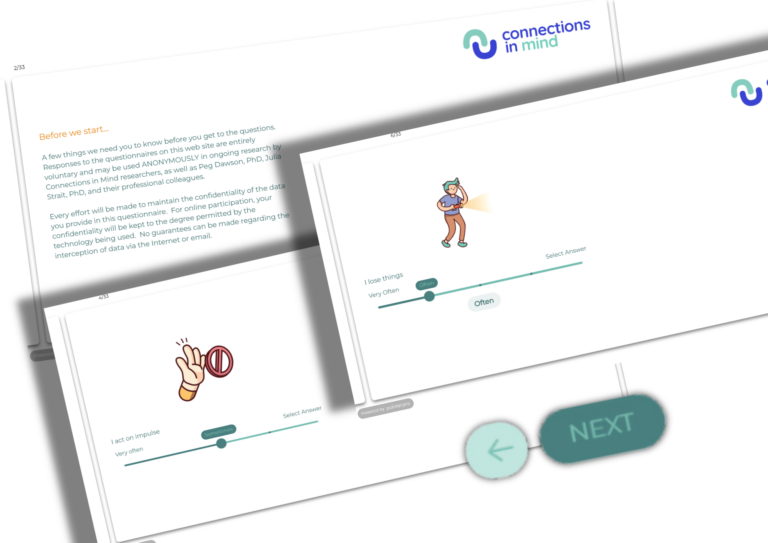
And that report has a graph. It will say what’s your strength – meaning, on which of your executive functions you score high – I believe that implies a calculated score of above five – and on which you score low. Say, for instance: “Response inhibition.” It’s all categorized into different executive functions.
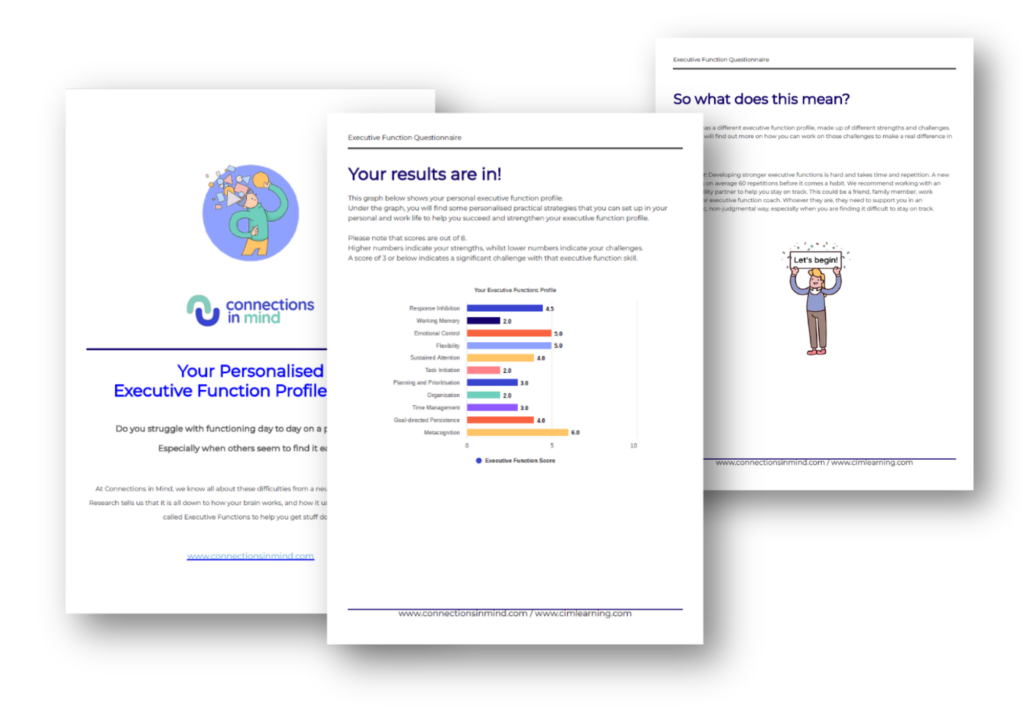
And then you get to the next pages. They explain your struggles in more depth. There’s also a page that explains what is “working memory” exactly. Then it talks about what you can do next, with links to our coaching initiatives as well and to the webinars that Jandre talked about earlier.
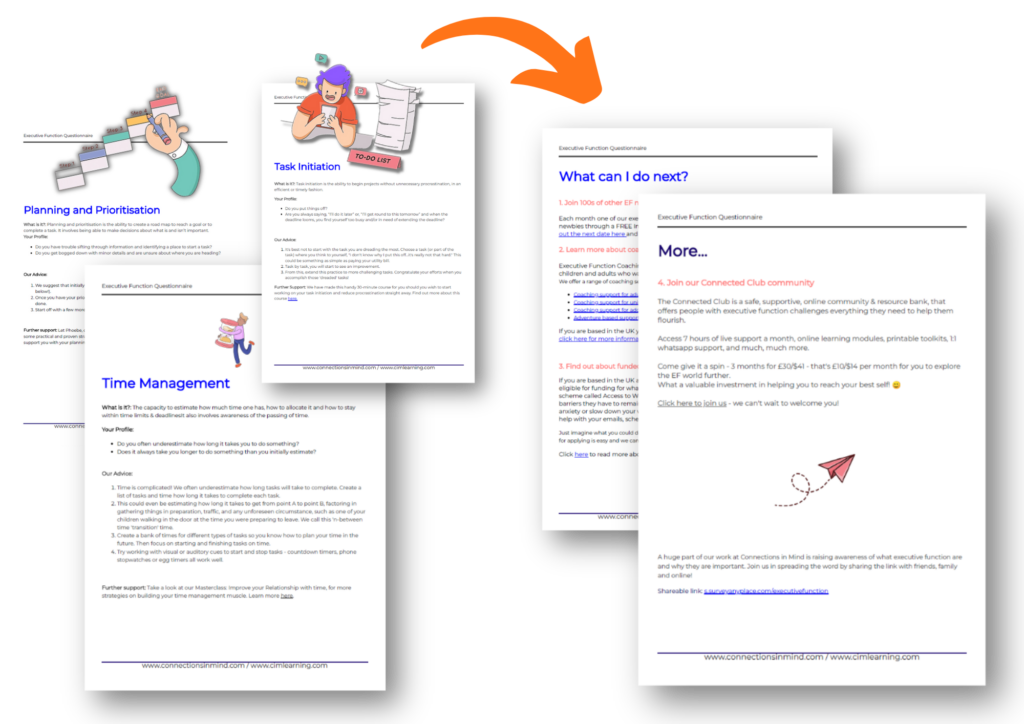
So that’s your journey while you’re doing the questionnaire. And we also have the emails that go out afterward and give you more resources.
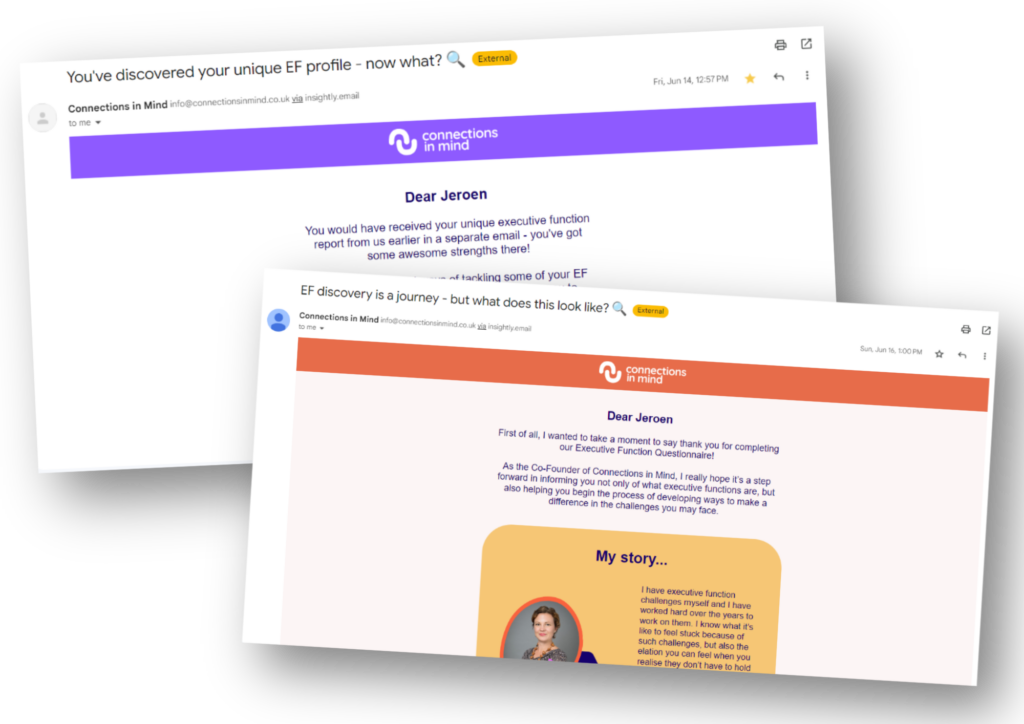
Nice. I quickly want to circle back to right before a user arrives on the questionnaire. How do people actually find the questionnaire?
Victoria: Yes, it’s up front and center everywhere, because we’ve found the assessment to be the most impactful way of explaining to people what executive functions are. We use it in all of our trainings to get people to understand what it is, we promote it on the website, we have Google Ads, we actually have a number of universities that use it as part of their intake… So, a lot of ways.
But mostly it comes from the Google Ads. I think we get some crazy click through rate. We get really good value for money on Google Ads because it’s really enticing for people to take a test and get live results. About 800 out of the 1000 respondents we get a month come in via Google Ads.

“We get really good value for money on Google Ads because it's really enticing for people to take a test and get live results.” - Victoria Bagnall (CEO & Co-founder)
Productizing and monetizing automated assessments in the future
You mentioned universities also use the questionnaire, or at least a version of it. Can you tell us more about that?
Victoria: Oh, so it’s actually one of the things that we’re we’re thinking of developing at the moment: a product that we can actually sell, because currently we don’t make any direct income from it and we do pay for a subscription, of course. We’d like to start monetizing it in some way.
And one of the things that we’ll do is offer it to education institutions who’d pay a subscription to us every year to get a certain amount of assessment reports. So, we’re developing those at the moment. But, it’s also one of those things that’s fallen down the to-do-list (laughs).
Prinel: We should mention the dashboards as well, maybe. This is something you wanted for the schools as well. We did speak about it with some people at Pointerpro and they said it was in the works…
There certainly is something in the works, indeed. I can confirm.
The overall satisfaction with Pointerpro
Looking back instead of forward one last time: You have this wonderful assessment and journey. Did you have anything like this before Pointerpro?
Victoria: It was pen and paper, mostly, before. And so I specifically went looking for something that was really engaging for our community because there are different bits of software out there that do similar things.
But what we liked about Pointerpro is the really clean design. It’s not overwhelming. It’s very kind of sensory, not too overstimulating. It’s really engaging for our neurodivergent community. And that’s just in the design itself.
And for any business who wants to be neuroinclusive – and we all need to be neuroinclusive as we move forward in the world – making sure that we’re designing things with neuro divergent people in mind, is really important. So for us, that was the key reason to choose Pointerpro.
We knew it was going to open things up for us if we could just find the software that could do this for us and do it well. We were just glad to have found Pointerpro and glad it worked because we have had some collaborations with some other tech companies that haven’t gone so well, haven’t we, guys? (laughs)

“We knew it was going to open things up for us if we could just find the software that could do this for us and do it well.” - Victoria Bagnall (CEO & Co-founder)
So we’re really glad that you were able to deliver on what you promised. So many people over promise what they can do and as a small organization, that can be so frustrating because you can literally put a huge proportion of your budget into a new project, and then it does not go anywhere.
So we we do pay a good amount for our Pointerpro subscription, but it adds that amount of value to our organisation. We’re happy to pay that for the quality of service we get.
Fantastic. To finish, are there any tips for people who are considering or starting with Pointerpro right now?
Victoria: Hm. There’s such a comprehensive how-to-guide. But also, I think the really responsive customer service team as well… like they’re super on it. I think with a lot of other places you have to wait two or three days for someone to get back to you, but Pointerpro gets back to you really quickly so you can keep going with your project. It’s really responsive.
So I would say, you know, look at all the resources and read up on what you’re trying to do. But if you do get stuck and it’s just not working or you can’t figure it out, then remember that the support is there if you need it.
Again, fantastic. Is there anything else anyone would like to add: about Pointerpro, Connections In Mind or executive functioning?
Victoria: Well, we’ve discussed a lot, so I just hope it resonated with anyone. If you want to know anything about executive functions, we’re here. We’re a community interest company. It’s not about profit for us. We just want to educate people. So please do get in contact with us. We’d be delighted to support you.

